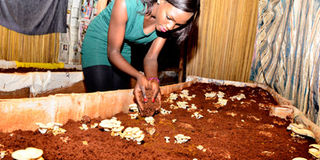Beauty queen on her life as a mushroom farmer

Left, a close up of the mushrooms. Above, Kalanguka uses a knife to harvest mature mushrooms. Right, she shows what she has harvested. PHOTOs BY DOMINIC BUKENYA
What you need to know:
Miss Uganda, who has just graduated from Makerere University with a degree in Computer Engineering, shared with Esther Oluka about her lesser-known involvement in mushroom farming.
I am Leah Kalanguka. I grow mushrooms for sale. The idea of considering agriculture was sold to me by my mother, Jane Bawaya Kalanguka, a few years ago while I was still in high school. She teaches agriculture at Makerere College School.
I did not consider it then because I was busy studying. I took up the idea eventually after she brought it up again early last year.
I was in my fourth year at the time pursuing a Bachelor of Science in Computer Engineering course.
I decided to grow pineapples first. She allowed me to do it in Busembatia in Iganga, my home district where our family owns a few acres of land.
Mid last year, I went to Iganga and started cultivating and planting with the help of my siblings. When we came back to Kampala, we left someone in charge tends to them.
Back here, I thought of growing something else. I wanted something that is easy to plant, matures very fast and could earn me some good amount of money. I asked a few family members of what to plant and they availed me with various options. The one that interested me the most was growing mushrooms.
Right behind our house, at the backyard was a designated portion of land which was not being used for anything.
My parents allowed me to use it for growing mushrooms. With the help of my siblings, we made a shelter surrounding it with reeds which we covered with newspapers and towels on the inside so as to keep out the light.
The dark, cool, moist and humid atmosphere is favourable for mushroom growing. Then, we bought stock (containing mushroom spawn and the medium) and planted it onto the soil to sprout. The start-up capital which was about Shs2million was contributed by my two older working sisters.
By the time they started sprouting, I was contesting for Miss Uganda. When I came back after the win, I found they had been harvested. Despite of this, I did not sit back and relax. I was still much involved in the growing and harvesting process of other mushrooms.
When some people got to know that I was involved in agribusiness after I won the beauty contest, they criticised me.
They could not imagine a Miss Uganda getting her hands dirty, participating in farm work. The fact remains, I love growing mushrooms. And I never let my responsibilities as Miss Uganda interfere with my farm activities.
When I am tending to the mushrooms, I am just like any other worker on the farm doing all sorts of things including planting and watering. And when the time finally comes when they are ready, I do the harvesting.
Advice to the youth
I advise all the youth out there that agriculture is the simplest way of making money. All you need to do is start small and then use the profits for expanding your business.
There will be times you will incur losses just like any other person involved in business but do not give up.
Continue working hard. I believe if most youth gave this a try; there would be a big difference in our country in terms of increase in food exports and job opportunities.
And for those interested in growing mushrooms, one of the things you need to have is passion.
When you love what you do, you will always succeed at doing it. Even when you encounter any sort of challenges, it is still easy to persevere.
Another thing you need to have is patience. When things do not go according to plan, always try to hang in there. Also, always try to market your business.
If you do not, you will not get customers, you need to put yourself out there so that people get to know what kind of business you do.
For instance, whenever I bump into people, I take the opportunity to tell them about my mushroom business. Telling people has helped grow the business.
The customers
Most of the clients who buy the mushrooms are members of the Church of the Resurrection in Bugolobi, market women and members of the Miss Uganda Foundation.
The price of one kilo of fresh mushrooms goes for Shs8,000 while one kilo of dried mushrooms is at Shs12,000.
All the mushrooms are for sell as we do not leave any for food consumption. Everyone in the family is involved in distributing them to these different clients.
We make an average profit of about Shs500,000 a month. We are saving this money to invest into other activities in future. We are for instance planning on making a huge farmhouse back in Busembatia where we shall be growing other foodstuffs besides pineapples.
Challenges
I have not faced any outstanding challenges yet since I have been growing the mushrooms for only a couple of months.
Probably what I can say is that the client base is growing and yet we cannot meet everyone’s demand since we grow the mushrooms on a small scale.
There have been instances where clients call me up requesting for mushrooms but then I have to tell them that they are finished and have to wait until another harvest. It is not a good thing for business.
Future plans
Our family owns some few acres of land in Mukono District that we want to clear in the near future and start growing more mushrooms. Once they have matured, we want to add value to some of the mushrooms. I am thinking of making products such as powder out of them.
Expert take>The basics of growing mushrooms
The keys to growing mushrooms at home are establishing the right growing conditions and acquiring or making mushroom spawn, which is the material used to propagate mushrooms.
How mushrooms grow
Mushrooms grow from spores--not seeds--that are so tiny that you cannot see individual spores with the naked eye. Because the spores do not contain chlorophyll to begin germinating (as seeds do), they rely on substances such as sawdust, grain, wooden plugs, straw, wood chips, or liquid for nourishment.
A blend of the spores and these nutrients is called spawn. Spawn performs a bit like the starter needed to make sourdough bread.
The spawn supports the growth of mushrooms’ tiny, white, threadlike roots, called mycelium.
The mycelium grows first, before anything that resembles a mushroom pushes through the growing medium.
The spawn itself could grow mushrooms, but you’ll get a lot better mushroom harvest when the spawn is applied to a substrate, or growing medium.
Depending on the mushroom type, the substrate might be straw, cardboard, logs, wood chips, or compost with a blend of materials such as straw, corncobs, cotton and cocoa seed hulls, gypsum, and nitrogen supplements.
Where to grow mushrooms
Mushrooms prefer dark, cool, moist, and humid growing environments. Test the proposed location by checking the temperature. Most mushrooms grow best in temperatures between 55 and 60 degrees F, away from drying, direct heat and drafts.
Enoki mushrooms prefer cooler temperatures, about 45 degrees F. Mushrooms can tolerate some light, but the spot you choose should stay relatively dark or in low light.
Some mushroom types grow outdoors in prepared ground or logs, a process that takes much longer (six months to three years) than in controlled environments inside.
Types of mushrooms to grow
There are many kinds of mushrooms. One of the beauties of growing your own instead of wild-harvesting them is that you can be sure you’re not picking a poisonous mushroom.
These mushrooms are the types most commonly grown at home: Crimini, Enoki, Maitake, Portobello, Oyster, Shiitake, White button.
Each type has specific growing needs. Grow white button mushrooms on composted manure, shiitakes on wood or hardwood sawdust, and oyster mushrooms on straw, for example.
Growing mushrooms
If you are growing mushrooms in your home, you have a couple of options for materials.
You can buy mushroom kits already packed with a growing medium that’s inoculated with mushroom spawn. Buying a kit is a good way to begin your knowledge of mushroom growing. If you start without a kit, the type of mushroom you choose to grow determines the substrate you grow the mushrooms on. Research each mushroom’s needs.
Button mushrooms are among the easiest types to grow. Use 14x16-inch trays about 6 inches deep that resemble seed flats. Fill the trays with the mushroom compost material and inoculate with spawn.
Use a heating pad to raise the soil temperature to about 70 degrees F for about three weeks or until you see the mycelium--the tiny, threadlike roots. At this point, drop the temperature to 55 to 60 degrees F. Cover the spawn with an inch or so of potting soil.
Keep the soil moist by spritzing it with water and covering it with a damp cloth that you can spritz with water as it dries. Button mushrooms should appear within three to four weeks. Harvest them when the caps open and the stalk can be cut with a sharp knife from the stem.
Avoid pulling up the mushrooms, or you risk damage to surrounding fungi that are still developing. Harvesting every day should result in a continuous crop for about six months.
Source: www.bhg.com




